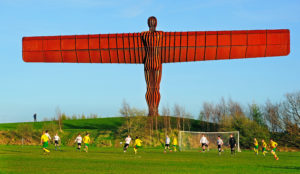If Brexit taught us anything, it’s that a sentimental yearning for the past underpins Global Britain’s sense of its own adorable character. And the brilliant thing about Great British Nostalgia is that it belongs to all of us — not just to Tories, expats and those flag-draped weirdos clutching teddy bears at Last Night of the Proms.
Yet somehow the perception is that nostalgia is the sole province of xenophobes. Well “newsflash”, as we used to say. Those of us on the Left also become more nostalgic as we get older. We too mourn the past. So, at a time of mounting scepticism about the public finance model for our denationalised industries, I commend this bible of calm rationalism: the British Rail Corporate Identity Manual.
The Manual, like the actual Bible, doesn’t need to be read linearly. It’s best experienced immersively, as a trove of browsable scripture. Oh, spoiler alert: both British Rail and the Bible end badly. One in terrifying madness, with everything destroyed by rapacious monsters, the other in a poorly-written Book of Revelation.
The Manual is a beautiful, heartbreaking anthology of design guides issued by BR between 1965 and 1970, the coolest and most swinging period in our modern social history. We had a proper Old Labour government, for a start. We had the Pill and the Mini and rising wages thanks to strong unions headed by people who sounded like us. Bliss was it in that dawn to be alive, but to be young was groovy heaven. The Beatles were turning us on, reinventing the future, in those long summery five years from Rubber Soul to Let It Be. The Open University was launched, decades before the internet made remote learning universally dull. Brutalist masterpieces redefined civic space and, along with atheism and cohabitation and drugs and whatnot, it really irritated older people, which made everything so much funnier.
We were a railway household in those days. My dad started as a fitter with British Railways after the war, and ended up working at British Rail’s new-look Euston during its modernisation. He revered The Euston Concourse as others revere St Peter’s Square; VIPs using the same space as the proles. I remember with affection Euston’s pristine egalitarian public space, yet to be slathered in shrieking adverts, yet to succumb to the inevitable rash of franchise buboes. God, I can even remember when the toilets were free.
We were passengers then, not customers. Passenger traffic, not just technical modernisation, drove the new-look BR. For the first time in the history of British railways, passengers had replaced freight as the main source of business; the company had to present itself as a legible, people-centred organisation. How refreshing it all seems today, when a privatised industry treats passengers as freight.
Also — nostalgia klaxon — it’s worth remembering that we weren’t “in Europe” at the time. BR’s assertive corporate identity was a cheerfully patriotic act. Tony Howard, former Head of Design for British Rail, was rightly proud of bringing sleek coherence to a post-Beeching railway system employing an army of 400,000 employees. “The Manual was designed to be a working tool,” he said. “It set the standard for how large corporate identities are implemented but more importantly how they are controlled”. Oh yeah, national identity, taking back control, wasn’t that a thing recently? Seriously, how come we’ve Brexited into a reality where two-thirds of the public support renationalisation yet 70% of our rail companies are currently owned by European states?
The re-creation of the Manual was a recent labour of love by graphic artist Wallace Henning, who assembled all these volumes of meticulous ring-bound sheets of corporate guidelines — the branding, livery, uniforms, minutiae and miscellany — initially via Kickstarter. Gathered together in a single book, they add up to more than just a quaint historical document. There’s something so utterly confident, so obliteratingly modern about the typefaces, fonts, logos and signage, even if sometimes the typographic notes sound a bit Mervyn Peake — “Where it is impossible to obtain typefaces of the Univers range the following are acceptable alternatives for text setting: Monotype Grotesque 215, Grotesque Bold 216, and Haas Type Foundary’s Neue Haas Grotesque Medium…” Gerald Barney’s iconic double-arrow logo, literally drawn on the back of an envelope on the Tube in to work, is everywhere. And very precisely commanded: “Note that the outer arrows broaden slightly towards their tips. If incorrectly drawn parallel they appear to taper outwards.” Like entasis in Classical architecture, where they fattened columns a bit in the middle to correct an optical illusion.
And oh my word ladies and gents, the Sixties uniforms. My mates and I may have been mincing about in ridiculous jumble-sale clothes on the last train home from Southend Victoria, but in the real world of public-sector service, British Rail staff looked sharp. The guards and train drivers in their worsted serge with silver buttons are the very picture of amiable Stalinism. As for the illustration of the female courier’s uniform, and the female courier within, well. She looks as impossibly chic to me now as she would have looked to me then, in her tailored jacket in worsted fine twill with semi-fit front, straight back and side hacking vents, flared skirt just above the knee, white poplin blouse finished with a kite-shaped cravat, and the sense behind that modest gaze of someone who reads Harold Robbins novels. Pretty sure I never encountered a British Rail courier; I would definitely have remembered.
When the Manual appeared in 2016 it was an instant hit with graphics geeks and font fetishists. I lack the technical expertise to appreciate it fully on those terms. For me, it’s a wormhole to a period I experienced as a teenager, when I could only gaze at the British Rail Catering Menu on Liverpool Street station and dream of a Tartan Plate for seven shillings and sixpence (“Entrecôte steak, fried egg, tomato, chips, roll and butter”). Or when, boarding a train, I’d scan the carriage windows for those clear of “No Smoking” or “Ladies Only” stickers. The new corporate identity offered a public domain of clarity, guiding us through a world of Newspapers, Cigarettes and Sweets. The signage and pictograms remain of course, like the Cheshire Cat’s smile. The rest is dust on the wind. Honestly, I wish I could remember being on a train back then and luxuriating in the knowledge that it was publicly owned. All I can remember is taking it for granted, which in a way I suppose is how we lost it. The last updates to the guidelines seem to have been issued in 1979-80, when it all still looked just as modern as it did in 1965. After 1979, for obvious reasons, our nationalised railway’s days were numbered.
As a book recommendation, the British Rail Corporate Identity Manual is, I concede, a far cry from Ulysses, that go-to, must-read Citizen Kane of books. Except weirdly the two books do have a resonance. “If Dublin were to be destroyed,” Joyce once drawled, rather grandly, “Ulysses could be used to rebuild it brick by brick.” It’s a glorious thought that we may one day awake from the paralysing hypnosis of battery-capitalism voodoo and say wait, where are we, what is this shit, is our public realm really best managed by succulent perma-tanned pirates with off-shore fortunes and excellent government contacts? Or indeed by other country’s governments?
And we will say to ourselves, no. No, it bloody well isn’t. And if we ever did decide to take back control and have a regulated, accountable, affordable public transport system, here’s a blueprint for what a railway should look like. Modern. Stylish. Ours.
Disclaimer
Some of the posts we share are controversial and we do not necessarily agree with them in the whole extend. Sometimes we agree with the content or part of it but we do not agree with the narration or language. Nevertheless we find them somehow interesting, valuable and/or informative or we share them, because we strongly believe in freedom of speech, free press and journalism. We strongly encourage you to have a critical approach to all the content, do your own research and analysis to build your own opinion.
We would be glad to have your feedback.
Source: UnHerd Read the original article here: https://unherd.com/



